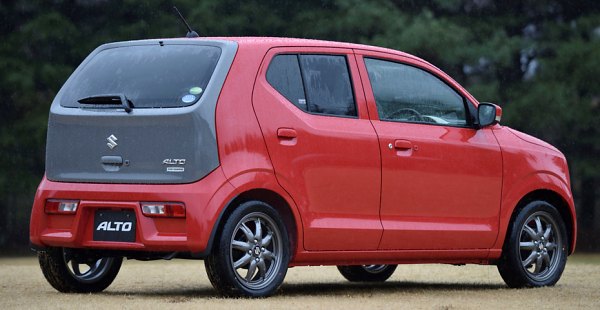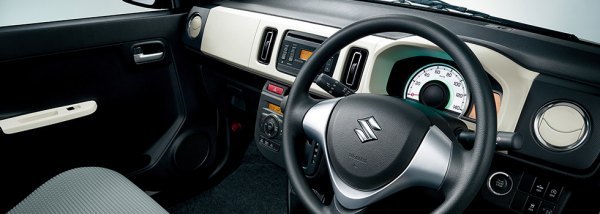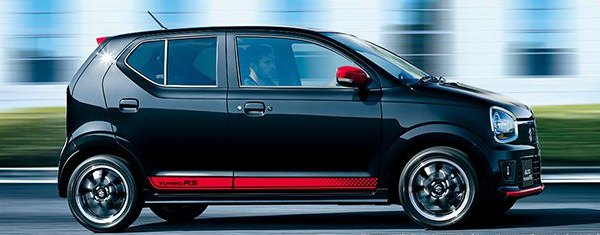Published
on 6
Jan 2017
|
All rights reserved.
|
|
|
What
a strange face!
It looks rather like the Roswell alien, doesn’t it?
Just like its looks suggested, the 8th generation Suzuki Alto is not
the usual Kei car. While most Kei cars look comically tall and narrow,
usually standing in excess of 1600mm above the ground, the Alto's
height is exactly the same as its 1475mm width. Even compared with its
already modest predecessor, it is 45mm lower. The smaller frontal area
and a less boxy shape cut aerodynamic drag significantly. Meanwhile,
the car is lightened by a further 60 kg, which equals to 10 percent of
its kerb weight! All these efforts were
made in a bid to improve fuel economy, which is a class-leading 37km
per liter according to JC08 standard. In fact, this is the most frugal
petrol-powered car in Japan. Among all Kei cars, only Daihatsu Mira e:S
comes closest to its philosophy, yet the Suzuki goes one step further
in every way.
 |
|
|
|
Born
in 1979, Alto is the longest running nameplate in the
world of Kei cars. However, it was rarely admired, because its market
positioning has always been at the lower end. In other words, it has
always been unsophisticated and cheap. The latest Alto does not break
away from this tradition. In fact, in the chase for weight reduction it
might be even leaner than ever. For example, its seats are thin and
have headrests integrated, so you cannot adjust the headrests. The rear
bench does not slide or split, so you have to sacrifice rear passengers
for luggage. The door panels are molded in one piece and lack any kind
of soft trimming. All in all, the Alto is designed to serve the basic
needs and no more.
However, this does not stop it from being funky. The Roswell face might
not be your cup of tea, but it does make the car stand out – I think
young people might love it. The black clamshell tailgate recalls my
fond memory of Lancia Y10.
The color decoration panel on the dashboard
lifts the ambience and relieves your regret for not having an
infotainment system. If there is the least painful way to live with a
cheap car, then this is it.
 |
|
|
|
The Alto is incredibly light. The base model with non-VVT engine and
manual
gearbox weighs only 610 kg, while the best selling CVT model tips the
scale at 650 kg. That’s an astonishing 155 kg lighter than a Smart
Fortwo, and considerably lighter than any other Kei cars as well.
Suzuki said it achieves this by using a lot of high- and ultra-high
strength steel to construct its monocoque body. This also increases its
rigidity by 30 percent. Compared with last generation, its wheelbase
has been stretched by 35mm to a remarkable 2460mm, no wonder the rear
seat offers enough legroom for adults.
Thanks to the extended wheelbase and stiffer chassis, the new car’s
ride quality and directional stability are much improved. The lower
center of gravity reduces body roll in corner significantly, especially
on cars fitted with front anti-roll bar (there was none previously).
Pulling just 650 kg of weight, the 52hp 3-cylinder DVVT engine and CVT
combo feels brisk enough. Like other Suzukis, it is bundled with a lot
of fuel saving technologies, such as automatic stop-start and a mild
hybrid system using integrated starter-generator.
 |
|
|
|
If
the 52hp engine is not enough, you may opt for the hotter
Turbo S. Its exterior enhancement and go-faster decals remind me
another Italian small car, Uno
Turbo i.e. The turbocharged engine produces 64hp which is also the
limit of K-cars, but it offers strong mid-range torque and again the
car is very light at 670kg. Roadholding and body control are improved
by stiffer suspension and 15-inch alloys wearing wider and grippier
Bridgestone RE050A rubbers. The body shell is strengthened with front
tower bar and extra spot welds. However, if you expect hot hatch
handling, you will be disappointed, because the car is troubled by many
flaws: slow and light steering, jerky gearshift from the 5-speed
automated manual, stiff ride, insufficient front-end grip hence
understeer, and the inside front wheel tends to spin in tight corners.
Some of these problems could be rectified by the range-topping Alto
Works, which is the Turbo RS enhanced with Recaro seats, a retuned
engine with slightly more torque, KYB performance shocks and a 5-speed
manual gearbox. However, the Alto is still more likeable in basic form.
|
Verdict:    |
|